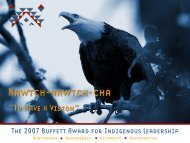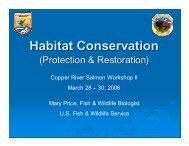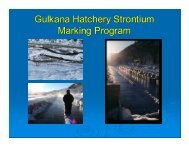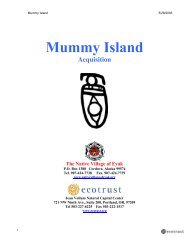History History of Gulkana Hatchery - Ecotrust
History History of Gulkana Hatchery - Ecotrust
History History of Gulkana Hatchery - Ecotrust
You also want an ePaper? Increase the reach of your titles
YUMPU automatically turns print PDFs into web optimized ePapers that Google loves.
<strong>History</strong> <strong>of</strong> <strong>Gulkana</strong> <strong>Hatchery</strong><br />
By<br />
Ken Roberson
Discussion Outline<br />
<br />
<br />
<br />
<br />
<br />
<br />
<br />
<br />
Recognition<br />
The Site<br />
The Concept<br />
Goals<br />
Development<br />
The Product<br />
Research<br />
Today
Recognition<br />
1969-1971 1971 Tag recovery focus on site<br />
Constant flow<br />
Open water year round<br />
Springs w/moss and Mimulus sp.<br />
Water always clear<br />
Lots <strong>of</strong> sockeye spawners<br />
1971-1973 1973 Sampling Confirmed Potential
The Site
The Concept<br />
BC Biologist Robby Bams &<br />
BC Engineer George Wilson<br />
Stream Side Incubator Design& & Use<br />
Visit by Biologist J. David Solf &<br />
Engineer George Cunningham from ADF&G<br />
Solf built and installed units near Cordova<br />
w/pink & chum eggs<br />
Some worked, some failed
The Concept (Cont’d)<br />
Consultations<br />
Dr. Bill McNeil, NMFS<br />
Biologist Jack Bailey, NMFS<br />
Bob Roys, ADF&G, FRED Div.<br />
Biologist Steve Pennoyer, ADF&G Comm. Fish<br />
Gil Ziemer & George Cunningham, ADF&G<br />
Engineering Staff
Goals<br />
Enhance Upper East Fork <strong>Gulkana</strong> Sockeye<br />
Wagon trail, 1918 road, 1964 flood resulting<br />
in major road widening – flood plain losses<br />
Flood in 1971 removed more spawning gravel<br />
Evaluate Stream Side Incubation System<br />
As Enhancement Technique<br />
Establish Brood Stock For Potential<br />
Expansion <strong>of</strong> Project
Development<br />
1973 – Single incubator w/ 220,000 eggs<br />
1974 – Add 4 units, Capacity 1.25 million eggs<br />
1979 – 10 units, 1980 – 20 units<br />
1981 – Funding Source changed to FRED Div.<br />
ADF&G from Comm. Fish Research<br />
1984 – 50 units, Capacity 25 million eggs<br />
1988 – 70 units, Capacity 35 million eggs<br />
1988 – Start Conversion to “Tote” incubators
Development (Cont’d)<br />
FRY STOCKING<br />
Paxson Lake - 79,500 to 13.3 million (1974<br />
to Present)<br />
Ten Mile Lake - ~ 100,000 (1974 – 1979)<br />
Summit Lake – 1.3 million to 15.0 million<br />
(1979 to Present)<br />
Crosswind Lake – 1.3 million to 10.5 million<br />
(1984 to Present)
<strong>Gulkana</strong> II
Chinook Program<br />
Develop remote egg take and egg transportation<br />
procedures<br />
Develop unmanned hatchery chinook incubation<br />
procedures<br />
Evaluate unutilized lake stocking site potential for rearing<br />
<strong>of</strong> chinook fry<br />
Conduct disease history sampling<br />
1987-1991<br />
1991<br />
<br />
<br />
<br />
Portion <strong>of</strong> fry release w/ CWT’s<br />
Fry left rearing lake almost immediately<br />
Modest adult return documented at hatchery site
The Product<br />
Largest sockeye facility !<br />
Largest streamside incubation facility !<br />
Only sockeye facility to survive “all” IHNV<br />
outbreaks without major loss !<br />
Facility operates “unmanned” most <strong>of</strong> year<br />
Facility not dependant upon pumps or<br />
generators for incubation – gravity system
Research<br />
Incubation Substrates<br />
Incubator Loading Densities<br />
Disinfection & Prophylactic Procedures<br />
IHNV Treatment & Prevention<br />
Incubator Design<br />
Egg Take Techniques<br />
Egg & Fry Counting Methods
Research (Cont’d)<br />
<br />
<br />
<br />
<br />
<br />
Limnology Sampling<br />
<br />
1980 to present Paxson, Summit & Crosswind<br />
Short Term Feeding Procedures<br />
Fry Transportation Methods<br />
CWT Tagging Procedures<br />
<br />
<br />
Summit Lake (1981 initiated)<br />
Crosswind Lake (1984 initiated)<br />
Strontium Marking Procedures (1999 initiated)
Research (Cont’d)<br />
Adult Counting/Sampling Weirs<br />
Summit Lake<br />
1984-1993 1993 Aerial Count w/ ground sampling<br />
Weir since 1994<br />
Crosswind Lake<br />
Weir since 1987<br />
Gravel Substrate Cleaning Techniques<br />
Improved Fish Sacrificing Procedures
Today<br />
IMPORTANT PROGRAM TOPICS<br />
(Speakers to follow this presentation)<br />
Strontium Marking – Gary Martinek<br />
CWT Program – Steve M<strong>of</strong>fitt<br />
Lake Limnology – Jim Edmondson



